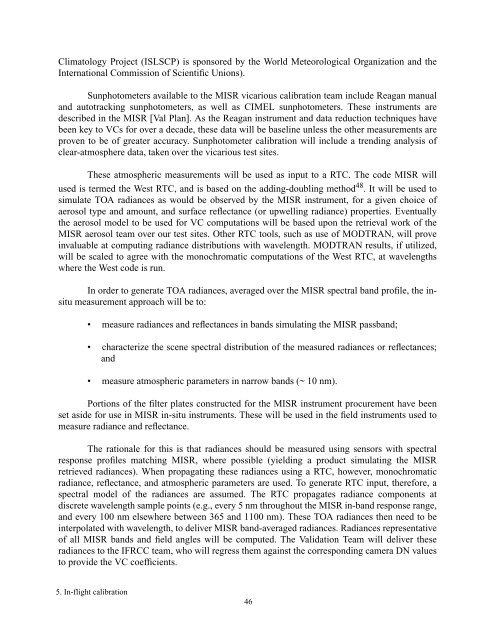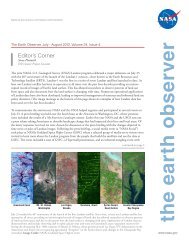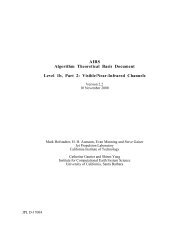MISR: In-Flight Radiometric Calibration and Characterization Plan
MISR: In-Flight Radiometric Calibration and Characterization Plan
MISR: In-Flight Radiometric Calibration and Characterization Plan
You also want an ePaper? Increase the reach of your titles
YUMPU automatically turns print PDFs into web optimized ePapers that Google loves.
Climatology Project (ISLSCP) is sponsored by the World Meteorological Organization <strong>and</strong> the<strong>In</strong>ternational Commission of Scientific Unions).Sunphotometers available to the <strong>MISR</strong> vicarious calibration team include Reagan manual<strong>and</strong> autotracking sunphotometers, as well as CIMEL sunphotometers. These instruments aredescribed in the <strong>MISR</strong> [Val <strong>Plan</strong>]. As the Reagan instrument <strong>and</strong> data reduction techniques havebeen key to VCs for over a decade, these data will be baseline unless the other measurements areproven to be of greater accuracy. Sunphotometer calibration will include a trending analysis ofclear-atmosphere data, taken over the vicarious test sites.These atmospheric measurements will be used as input to a RTC. The code <strong>MISR</strong> willused is termed the West RTC, <strong>and</strong> is based on the adding-doubling method 48 . It will be used tosimulate TOA radiances as would be observed by the <strong>MISR</strong> instrument, for a given choice ofaerosol type <strong>and</strong> amount, <strong>and</strong> surface reflectance (or upwelling radiance) properties. Eventuallythe aerosol model to be used for VC computations will be based upon the retrieval work of the<strong>MISR</strong> aerosol team over our test sites. Other RTC tools, such as use of MODTRAN, will proveinvaluable at computing radiance distributions with wavelength. MODTRAN results, if utilized,will be scaled to agree with the monochromatic computations of the West RTC, at wavelengthswhere the West code is run.<strong>In</strong> order to generate TOA radiances, averaged over the <strong>MISR</strong> spectral b<strong>and</strong> profile, the insitumeasurement approach will be to:• measure radiances <strong>and</strong> reflectances in b<strong>and</strong>s simulating the <strong>MISR</strong> passb<strong>and</strong>;• characterize the scene spectral distribution of the measured radiances or reflectances;<strong>and</strong>• measure atmospheric parameters in narrow b<strong>and</strong>s (~ 10 nm).Portions of the filter plates constructed for the <strong>MISR</strong> instrument procurement have beenset aside for use in <strong>MISR</strong> in-situ instruments. These will be used in the field instruments used tomeasure radiance <strong>and</strong> reflectance.The rationale for this is that radiances should be measured using sensors with spectralresponse profiles matching <strong>MISR</strong>, where possible (yielding a product simulating the <strong>MISR</strong>retrieved radiances). When propagating these radiances using a RTC, however, monochromaticradiance, reflectance, <strong>and</strong> atmospheric parameters are used. To generate RTC input, therefore, aspectral model of the radiances are assumed. The RTC propagates radiance components atdiscrete wavelength sample points (e.g., every 5 nm throughout the <strong>MISR</strong> in-b<strong>and</strong> response range,<strong>and</strong> every 100 nm elsewhere between 365 <strong>and</strong> 1100 nm). These TOA radiances then need to beinterpolated with wavelength, to deliver <strong>MISR</strong> b<strong>and</strong>-averaged radiances. Radiances representativeof all <strong>MISR</strong> b<strong>and</strong>s <strong>and</strong> field angles will be computed. The Validation Team will deliver theseradiances to the IFRCC team, who will regress them against the corresponding camera DN valuesto provide the VC coefficients.5. <strong>In</strong>-flight calibration46







